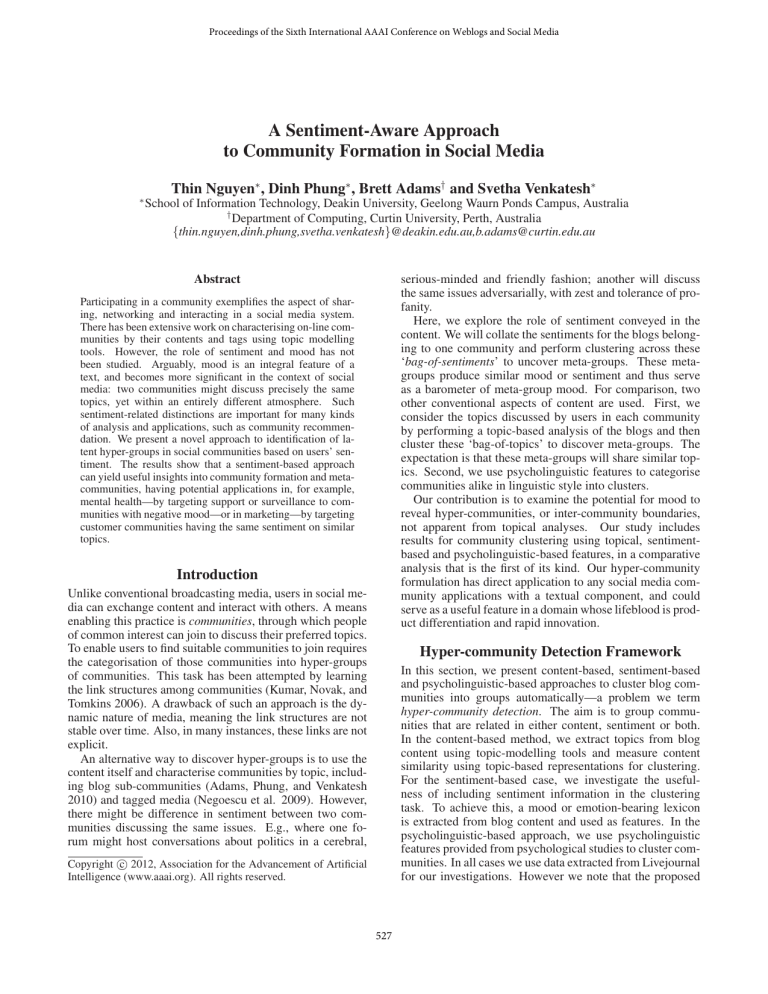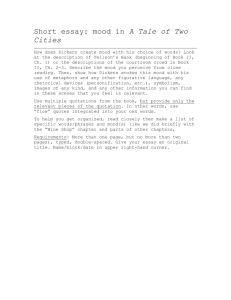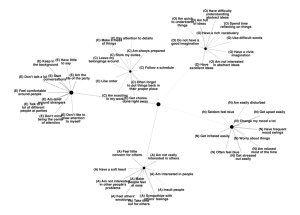
Proceedings of the Sixth International AAAI Conference on Weblogs and Social Media
A Sentiment-Aware Approach
to Community Formation in Social Media
∗
Thin Nguyen∗ , Dinh Phung∗ , Brett Adams† and Svetha Venkatesh∗
School of Information Technology, Deakin University, Geelong Waurn Ponds Campus, Australia
†
Department of Computing, Curtin University, Perth, Australia
{thin.nguyen,dinh.phung,svetha.venkatesh}@deakin.edu.au,b.adams@curtin.edu.au
serious-minded and friendly fashion; another will discuss
the same issues adversarially, with zest and tolerance of profanity.
Here, we explore the role of sentiment conveyed in the
content. We will collate the sentiments for the blogs belonging to one community and perform clustering across these
‘bag-of-sentiments’ to uncover meta-groups. These metagroups produce similar mood or sentiment and thus serve
as a barometer of meta-group mood. For comparison, two
other conventional aspects of content are used. First, we
consider the topics discussed by users in each community
by performing a topic-based analysis of the blogs and then
cluster these ‘bag-of-topics’ to discover meta-groups. The
expectation is that these meta-groups will share similar topics. Second, we use psycholinguistic features to categorise
communities alike in linguistic style into clusters.
Our contribution is to examine the potential for mood to
reveal hyper-communities, or inter-community boundaries,
not apparent from topical analyses. Our study includes
results for community clustering using topical, sentimentbased and psycholinguistic-based features, in a comparative
analysis that is the first of its kind. Our hyper-community
formulation has direct application to any social media community applications with a textual component, and could
serve as a useful feature in a domain whose lifeblood is product differentiation and rapid innovation.
Abstract
Participating in a community exemplifies the aspect of sharing, networking and interacting in a social media system.
There has been extensive work on characterising on-line communities by their contents and tags using topic modelling
tools. However, the role of sentiment and mood has not
been studied. Arguably, mood is an integral feature of a
text, and becomes more significant in the context of social
media: two communities might discuss precisely the same
topics, yet within an entirely different atmosphere. Such
sentiment-related distinctions are important for many kinds
of analysis and applications, such as community recommendation. We present a novel approach to identification of latent hyper-groups in social communities based on users’ sentiment. The results show that a sentiment-based approach
can yield useful insights into community formation and metacommunities, having potential applications in, for example,
mental health—by targeting support or surveillance to communities with negative mood—or in marketing—by targeting
customer communities having the same sentiment on similar
topics.
Introduction
Unlike conventional broadcasting media, users in social media can exchange content and interact with others. A means
enabling this practice is communities, through which people
of common interest can join to discuss their preferred topics.
To enable users to find suitable communities to join requires
the categorisation of those communities into hyper-groups
of communities. This task has been attempted by learning
the link structures among communities (Kumar, Novak, and
Tomkins 2006). A drawback of such an approach is the dynamic nature of media, meaning the link structures are not
stable over time. Also, in many instances, these links are not
explicit.
An alternative way to discover hyper-groups is to use the
content itself and characterise communities by topic, including blog sub-communities (Adams, Phung, and Venkatesh
2010) and tagged media (Negoescu et al. 2009). However,
there might be difference in sentiment between two communities discussing the same issues. E.g., where one forum might host conversations about politics in a cerebral,
Hyper-community Detection Framework
In this section, we present content-based, sentiment-based
and psycholinguistic-based approaches to cluster blog communities into groups automatically—a problem we term
hyper-community detection. The aim is to group communities that are related in either content, sentiment or both.
In the content-based method, we extract topics from blog
content using topic-modelling tools and measure content
similarity using topic-based representations for clustering.
For the sentiment-based case, we investigate the usefulness of including sentiment information in the clustering
task. To achieve this, a mood or emotion-bearing lexicon
is extracted from blog content and used as features. In the
psycholinguistic-based approach, we use psycholinguistic
features provided from psychological studies to cluster communities. In all cases we use data extracted from Livejournal
for our investigations. However we note that the proposed
c 2012, Association for the Advancement of Artificial
Copyright Intelligence (www.aaai.org). All rights reserved.
527
06
method is directly applicable to similar datasets.
We crawled the communities listed in the Livejournal
directory.1 From the 579 communities obtained, we extracted a subset consisting of the top 100 communities
having the most members across 10 categories (AdviceSupport, Creative-Expression, Entertainment-Music, Fandom, Fashion-Style, Food-Travel, Gaming-Technology,
Parenting-Pets, Politics-Culture and Television), resulting in
a dataset of 211,740 posts by 59,496 users.
dog overs
dogsintraining
05
cat lovers
note to cat
computer help
computerhe p
04
pod
Proportion
macintosh
htmlhelp
webdesign
03
02
01
Community representation
0
On-line communities come in many shapes and sizes and
are affected by many factors, including the demographics of
their members, reason for existence and facilities afforded
by the hosting application. The Livejournal blog site includes a community feature. Each community is defined by
the scope of topics it aims to host and comprises, among
other things, members and posts.
10
15
20
25
30
35
40
45
50
Topics
Topic
Top Topic Terms
dog dogs
baby months
puppy
9
16
milk
question
thanks
training
tried
dear cat
Topic-based representation To represent what community members talk about, we apply Latent Dirichlet Allocation (LDA) (Blei, Ng, and Jordan 2003)—a Bayesian probabilistic topic model—to the corpus of blog posts. All posts
for each community are aggregated to form the corpus input
to LDA, wherein each post is considered as one document.
LDA learns the probabilities p (vocabulary | topic), that are
used to describe a topic and assigns a topic to each word in
every document. Each post can then be represented as a mixture of topics using the probability p (topic | document). A
topic-based representation for each community is then constructed based on topic mixtures for those blog posts belonging to that community. We expect similar communities to
discuss a similar mix of topics, and hence to have a similar
mixture of p (topic | document) aggregated from their posts.
Formally,
let J be the number
of communities, denote by
xj = x1j , x2j , . . . , xnj j the set of posts in community
j where nj is the total number of posts by this community.
J
Thus, the corpus to be modelled consists of N = j=1 nj
documents aggregated from all communities D = ∪Jj=1 xj .
Finally, if θij denotes the topic mixture for blog
post xij ,
nj
community j can be represented by θj = (1/nj ) i=1
θij .
θj is a K-dimensional vector, where K is the number of topics used by LDA and the k th element represents the mixture
proportion of topic k for community j.
The topic distributions are well separated among some
groups of communities. As can be seen in Figure 1,
{dog lovers, dogsintraining} could be inferred as a group
of communities mainly talking about the character Dog
(topic 9); similarly, {cat lovers, note tocat} about cat (topic
20); {macintosh, computer help, computerhelp, ipod} about
computer/ipod (topic 23); and {webdesign, htmlhelp} about
web design (topic 29).
20
bed
vet
water
sleep
animal
gets
star ed
ried
v t
outs de
pet
mo ths
house
sleep weeks month
hospital
doctor
cats
mom
eat
food
big
daughter
stop
eat
k tten
23
using apple mac thanks drive files screen
code
website
links
layout
click
background
text
thank
walk
away
couple
pain
mommy
l tter
ot y
birth started
glad
kitty
room
un
bg
ov s
start
we ght
thank
clean
windows itunes
file running internet music
link table page
29
prob em
breast
computer ipod tried problem
fix
open
down oad
thanks site
journal
picture
change
entries
post
box
entry
Figure 1: Above: topic proportions of 10 communities.
Below: example topics and most likely words sized by
p (word | topic).
topic. Two methods to extract sentiment from a community are used in this study. If a blog post was tagged with a
mood when it was composed, we can use this information to
compute an overall sentiment for the community based on
moods aggregated from its posts. Otherwise, when mood is
not available, we propose to use a sentiment bearing lexicon.
Using mood Livejournal offers 132 moods for users to
tag their posts. We assume that there exists a difference in
tagged moods among communities, supporting the intuition
that such communities can be grouped by mood.
Let M= {sad, happy, ...} again be the predefined set of
moods where |M| = 132 is the total number of moods provided by Livejournal. Using the notation in the previous
section, each blog post xij in the j th community is further
tagged with a mood mij ∈ M. For each community, a
132-dimension mood usage vector mj is constructed whose
k th element is the number of times the k th mood in M was
tagged within this community.
Figure 2 shows a plot of the mood usage by eight different
communities in Livejournal. It can be seen that the mood usage in one group of communities (computer help, computerhelp, htmlhelp, ipod, webdesign) is well separated from another group (ncisficfind, sgagenrefinders, sgastoryfinders).
Sentiment-based representation Instead of grouping
communities based on their topics as in the previous section, we group communities based on sentiment. Sentiment
extracted from blog posts is analysed without considering
1
5
http://www.livejournal.com/browse/, retrieved July 2011.
528
0 18
0 16
0 14
Proportion
For topical hyper-communities, we note that each θ j is
a proper probability mass function over topics, summing
up to 1. For sentiment and psycholinguistic-based hypercommunities, the feature vectors are normalised. Thus, any
suitable probability distance functions can be employed to
compute the similarities. In this work, we use the negative
Kullback–Leibler divergence (Kullback and Leibler 1951).
computer help
computerhelp
htmlhelp
ipod
webdesign
ncisficfind
sgagenrefinders
sgastoryfinders
02
0 12
01
0 08
0 06
Hyper-community Detection Results
0 04
0 02
Overall clustering performance for the different community representations—topic, mood, mood-proxy and psycholinguistic—is shown in Table 1. We report cluster purity and Normalised mutual information (NMI) (Manning,
Raghavan, and Schütze 2008) using the Livejournal community classification, which is a topical classification, as the
groundtruth. Therefore, it is expected that these metrics will
be highest for the topic-based community representation.
We are chiefly concerned with new knowledge discovered
using mood-related representations, which will be analysed
in more detail below for each type of representation.
confused
annoyed
frustrated
worried
creative
p*ssed off
flirty
aggravated
Moods
cranky
content
sleepy
excited
optimistic
chipper
grateful
cheerful
cold
bouncy
tired
hopeful
0
Figure 2: An illustration of mood usage proportions in
two groups of communities: {computer help, computerhelp,
htmlhelp, ipod, webdesign} and {ncisficfind, sgagenrefinders, sgastoryfinders}.
The first group favours using moods having low valence
(such as p*ssed off, worried and confused) while the second prefers high valence moods (for instance, hopeful), empirically suggesting that it is sensible to study grouping behaviour based on mood.
No. Clusters
Purity
NMI
Using an emotion bearing lexicon When mood ground
truth is not available, sentiment-based hyper-community detection can be performed using vectors of sentiment bearing
words. In this paper we use the Affective Norms for English
Words (ANEW) (Bradley and Lang 1999). ANEW is a set of
1034 sentiment-conveying words rated in terms of valence,
arousal and dominance.
In this representation, each j th community is now represented with a 1,034-dimension ANEW feature vector aj ,
whose k th element is the number of times the k th ANEW
word is used in the content of the blog posts made by users
belonging to the community.
Mood
9
46%
43%
ANEW
15
63%
59%
LIWC
12
54%
51%
Table 1: Cluster purity and NMI of the clusterings based on
different community representations.
Topic-based hyper-groups
Using LDA with 50 topics yielded 20 hyper-communities.
Clustering appears to have gathered topically similar communities together in a number of cases (e.g., {ofmornings,
bentolunch, picturing food, trashy eats}), but also elucidated finer distinctions (such as in the cases of {cat lovers,
note to cat} and {dog lovers, dogsintraining}). On further inspection, a number of its communities have a significant romance or relationships component. E.g., in addition to those communities with obvious topics, three
are about particular fictional relationships: house cameron,
sheldon penny and time and chips.
It is found that, in the feature space, the intracategory distances are much smaller than inter-category distances. The smallest distance is between hyper-communities
{cat lovers, note tocat} and {dog lovers, dogsintraining},
which indicates the high degree of topical commonality of
discussion about pets, despite their being different animals.
It is interesting to note how close Entertainment-Music and
Politics-Culture are. The farthest distance is found between
Food-Travel and Gaming-Technology or Fandom.
Psycholinguistic-based representation As a final point
of comparison that bridges pure topical and sentiment-based
representation of communities, we use psycholinguistic features drawn from the Linguistic Inquiry and Word Count
(LIWC) package (Pennebaker, Francis, and Booth 2007).
The LIWC package assigns English words to one of 68 linguistic and psychological features.2 These LIWC features
are used to build a vector to provide a psycholinguistic representation of each community.
Community clustering
To group communities into hyper-communities we use affinity propagation algorithm (AP) (Frey and Dueck 2007)—a
non-parametric clustering algorithm. AP can automatically
discover the number of clusters as well as the cluster exemplars. This is crucial in our setting as the number of
hyper-communities can be extremely difficult to know in advance. The algorithm requires the pairwise similarities between data points. In our case, it is the similarity computed
between θ j and θ l for the (j, l)-pair of communities.
2
Topic
20
70%
62%
Mood-based hyper-groups
Clustering based on explicit mood labels yielded nine hypercommunities. In contrast to the topic-based clustering,
only two hyper-communities have 100 per cent purity with
respect to the topical ground truth, one of which (htmlhelp, computer help, computerhelp, ipod, webdesign, from
Gaming-Technology) is characterised by negative mood.
http://www.liwc.net/descriptiontable1.php, retrieved Jan 2012.
529
ability to recover non-topical features of a community such
as prevailing intent and atmosphere of discussion. However,
contrary to expectations, ANEW does not appear to be a
well-suited and cheap alternative to mood-based representation for the task of hyper-community detection.
The clustering results for LIWC’s psycholinguistic representation are worthy of follow-up. LIWC offers a wide
scope of classification—due to including topical, linguistic,
stylistic and mood categories—yet is cheap to obtain. Some
of the distinctions captured by the hyper-communities arising from LIWC representation are a kind of topic + atmosphere that seems relevant to the Web 2.0 denizen, who is
faced with a surfeit of choice and whose decision as to which
community they will invest in may turn on the presence of
more than one characteristic of the content. Consequently,
psycholinguistic analysis demonstrates potential for use in
community recommendation (and analysis).
Mood-based clustering reveals distinctions not apparent
in the topic-based representation. E.g., the group including behind the lens, while having significant overlap with
the group with behind the lens in the topic-based clustering, has some illuminating differences: gone are the
communities beatlepics, madradstalkers, ru glamour, topmodel and worldtourist; replacing them are add a writer,
just good music and ofmornings.
From an appraisal of the content of these communities
we find the distinctions to be nuanced. The topic-based
hyper-community is loosely united by pictures and people,
whereas the mood-based hyper-community is united by the
desire to create and its outcomes—differences that are best
explained by prevailing mood and intent. Indeed, these distinctions are captured by the predominant moods of the different hyper-communities, respectively curious, cheerful or
happy versus calm, accomplished and creative.
ANEW-based hyper-groups
Conclusion
Clustering based on ANEW features as proxy mood yielded
15 hyper-communities. Of these, five consisted of communities with matching Livejournal categories (e.g., curlyhair, beauty101, dyed hair and vintagehair all classified
as Fashion-Style). Two hyper-communities are examples
of the sub-category distinctions returned by the topic-based
clustering: {macintosh, computer help, computerhelp, ipod,
webdesign} and {worldofwarcraft, gamers, wow ladies} are
both from Livejournal’s Gaming-Technology category.
We have investigated the problem of discovering hypergroups of communities by using topics, sentiment information and psycholinguistic properties of the posts of members. We presented an unsupervised approach based on a
non-parametric algorithm to detect hyper-groups of communities in the blogosphere and to reveal interesting content-,
sentiment- and psycholinguistic-based grouping behaviours.
We have proposed a novel approach for addressing hypercommunity detection based on users’ sentiment. The grouping of meta-communities based on sentiment information
has potential applications in, e.g., mental health or in marketing. In addition, the psycholinguistic hyper-groups detected provide insight into the language styles of people in
specific categories (e.g., Fashion-Style bloggers favour spoken language) while topical hyper-groups enable users to
find suitable communities based on their interests.
LIWC-based hyper-groups
Clustering based on psycholinguistic features yielded 12
hyper-communities.
Three hyper-communities contain
communities with the same Livejournal category and appear
to have been associated topically. The top three LIWC categories for these hyper-communities are illuminating: for
Fashion-Style, feel, body and percept (i.e., perceptual processes); for Food-Travel, ingest, bio (i.e., biological processes) and percept and for Parenting-Pets, family, health
and humans (e.g., adult, baby and boy).
Other hyper-communities appear to exhibit a characteristic mixture of topic and style of discussion, which is in
part captured by the psycholinguistic processes of LIWC.
E.g., {sheldon penny, adayinmylife, house cameron, miracle
, rpattz kstew and time and chips} aggregates all of
the communities in the dataset about fictional relationships
(plus one community about documenting a day in one’s life).
These communities are a kind of meta-genre not easily captured by topical features alone. Linguistic features, such as
post length and extensive use of the third personal singular
(i.e., shehe), appear to help associate these communities.
References
Adams, B.; Phung, D.; and Venkatesh, S. 2010. Discovery of latent
subcommunities in a blog’s readership. ACM Transactions on the
Web 4(3):1–30.
Blei, D.; Ng, A.; and Jordan, M. 2003. Latent Dirichlet allocation.
Journal of Machine Learning Research 3:993–1022.
Bradley, M., and Lang, P. 1999. Affective norms for English words
(ANEW): Instruction manual and affective ratings. University of
Florida.
Frey, B., and Dueck, D. 2007. Clustering by passing messages
between data points. Science 315:972–976.
Kullback, S., and Leibler, R. 1951. On information and sufficiency.
The Annals of Mathematical Statistics 22(1):79–86.
Kumar, R.; Novak, J.; and Tomkins, A. 2006. Structure and evolution of online social networks. In Proc. of SIGKDD, 617.
Manning, C.; Raghavan, P.; and Schütze, H. 2008. Introduction to
information retrieval. Cambridge University Press.
Negoescu, R.; Adams, B.; Phung, D.; Venkatesh, S.; and GaticaPerez, D. 2009. Flickr hypergroups. In Proc. of ACMMM, 813.
Pennebaker, J.; Francis, M.; and Booth, R. 2007. Linguistic inquiry
and word count (LIWC) [computer software]. LIWC Inc.
Discussion
It is not surprising that the different community representations lead to hyper-communities that reflect these varying emphases. Topic-based representation is the method
of choice for recovering hierarchy within, and associations
across, Livejournal’s canonical topic categories. Likewise,
the results for the mood-based representation indicate an
530






